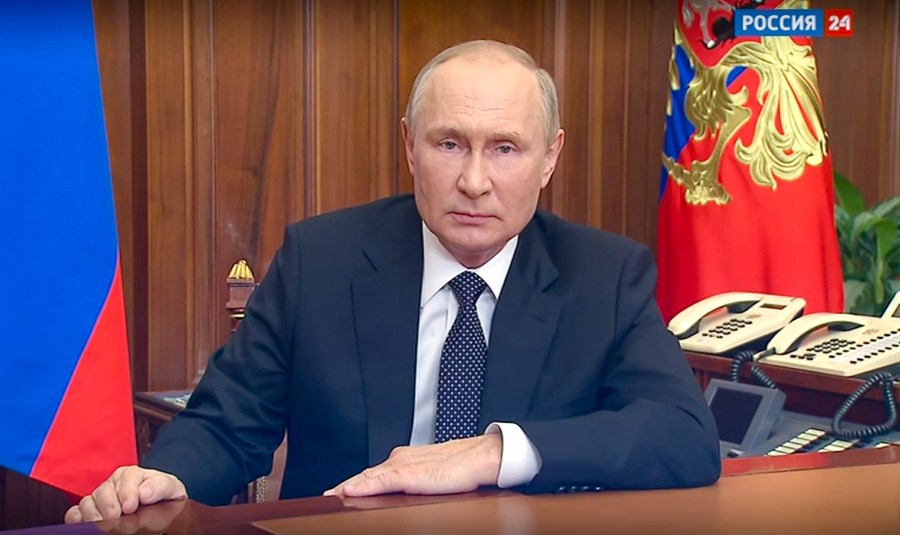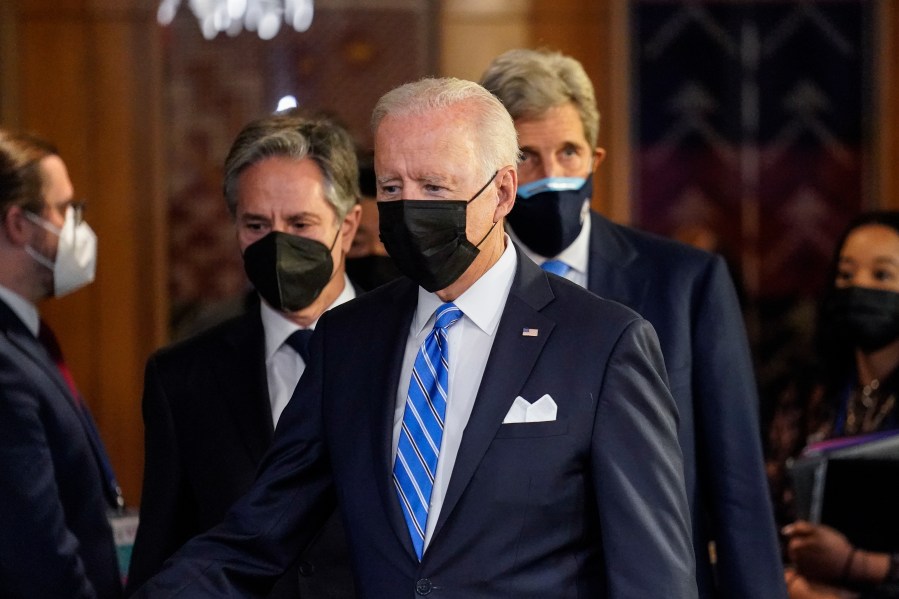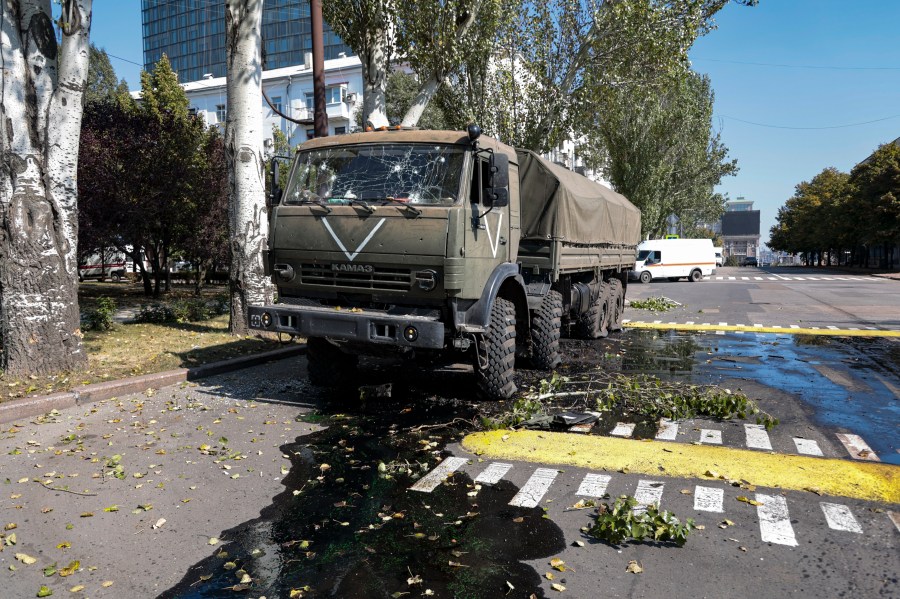Five takeaways from Putin’s speech ramping up the Ukraine war
Russian President Vladimir Putin delivered a rare address to the nation on Wednesday, putting the West on nuclear notice and mobilizing hundreds of thousands of additional troops for his war in Ukraine.
The speech followed two weeks of embarrassing losses to Ukrainians, who took back thousands of square kilometers of occupied territory in the northeast in a stunning counteroffensive.
The Ukrainian rout spurred criticism of the war on Russian state TV and among some Putin allies, posing the toughest test to his leadership yet.
Here are five takeaways from his address on Thursday.
Partial mobilization

Russian paratroopers lined up in the shape of the letter Z, which has become a symbol of the Russian military, attend celebrations for Paratroopers Day in Red Square in Moscow, Russia. (AP Photo)
Putin announced a partial mobilization effective Sept. 21, a move that his defense minister said would call up roughly 300,000 reservists.
The move came short of full mobilization or conscription, which would force civilians into the war. But it still risks bringing the war closer to home for many Russians, posing a political risk for Putin, who initially raised expectations that the war could be won in a matter of days.
“As I have said, we are talking about partial mobilization. In other words, only military reservists, primarily those who served in the armed forces and have specific military occupational specialties and corresponding experience, will be called up,” Putin said.
“Before being sent to their units, those called up for active duty will undergo mandatory additional military training based on the experience of the special military operation.”
The decision is likely to appease Ukraine war hawks, who have been clamoring for Putin to ramp up manpower to beat back Ukraine’s advances and turn the tide of the war.
However, the announcement sent shockwaves across the country, with reports of small-scale anti-mobilization protests across the country, and flights leaving Russia quickly selling out.
Nuclear threat

In this image made from a video released by the Russian Presidential Press Service, Russian President Vladimir Putin addresses the nation in Moscow, Russia. (Russian Presidential Press Service via AP)
Putin accused the West of “nuclear blackmail,” and made explicit threats about deploying Moscow’s own formidable nuclear stockpile.
“When the territorial integrity of our country is threatened, we, of course, will use all the means at our disposal to protect Russia and our people,” Putin said.
“This is not a bluff. And those who try to blackmail us with nuclear weapons should know that the weathervane can turn and point towards them.”
The Russian leader has made veiled nuclear threats throughout the war, warning when his invasion began in February that Western intervention “will lead you to such consequences that you have never encountered in your history.”
However, US officials have generally played down fears that Putin might make good on the threat.
John Kirby, spokesman for the White House’s National Security Council, told ABC’s “Good Morning America” on Wednesday that the U.S. was taking Putin’s “irresponsible” threat “seriously.”
President Biden mentioned Putin’s “irresponsible nuclear threats” in his address to the U.N. General Assembly on Wednesday, adding “a nuclear war cannot be won, and must never be fought.”
West has ‘crossed every line’

President Joe Biden, center, alongside Antony Blinken U.S. Secretary of State, left, and John Kerry, U.S. Special Presidential Envoy for Climate, right, leave following his speech at United Nations headquarters. (AP Photo/John Minchillo, Pool)
Putin repeatedly framed the war in Ukraine as a global showdown with the western world, which he said had “crossed every line” in what he described as efforts to wipe out Russia.
“In its aggressive anti-Russian policy, the West has crossed every line. We constantly hear threats against our country and our people,” he said.
“The purpose of this West is to weaken, divide and ultimately destroy our country. They are already saying that in 1991 they were able to break up the Soviet Union, and now the time has come for Russia itself that it should disintegrate. And they have been planning it for a long time.”
The Biden administration, along with governments in Europe, have become increasingly aggressive as the war has dragged on in their support for Ukraine, providing increasingly heavy weapons being used to inflict serious damage to Russian forces on the ground.
However, those arms have been provided with strict conditions that they not be used on targets in Russia, for fear of triggering a wider war. And the U.S. and allies such as Germany has resisted calls to provide even heavier missile systems, tanks and fighter jets.
Putin also claimed that Ukraine would have been willing to concede to Russia’s demands before the invasion — such as agreeing to never join NATO and cede contested territory — but that the West instead forced Kyiv into the war.
“More weapons were pumped into Ukraine,” he said. “The Kyiv regime brought into play new groups of foreign mercenaries and nationalists, military units trained according to NATO standards and receiving orders from Western advisers.”
Referendums in occupied areas

A damaged vehicle of the Russian military parked in street in Donetsk, area controlled by Russian-backed separatist forces, eastern Ukraine. (AP Photo/Alexei Alexandrov)
The Russian leader gave his full support to independence referendums planned in Russian occupied regions, which are seen as a pretext for Russian annexation.
“Parliaments in the People’s Republics of the Donbas as well as the civil-military administrations in Kherson and Zaporizhzhia regions have decided to hold referendums on the future of the territories and have appealed to Russia to support such a step. We will do everything to ensure safe conditions to hold the referendums so that people can express their will,” Putin said.
“We will support the decision on their future, which will be made by the majority of residents in the Donetsk and Luhansk People’s Republics, Zaporizhzhia and Kherson.”
The White House on Tuesday described the votes as “sham referendums” and said the U.S. would not recognize the outcomes should they materialize.
“We know that these referenda will be manipulated. We know that Russia will use the sham referenda as a basis to purportedly annex these territories, either now or in the future,” national security adviser Jake Sullivan said at a press conference.
“Let me be clear: If this does transpire, the United States will never recognize Russia’s claims to any purportedly annexed parts of Ukraine. We will never recognize this territory as anything other than a part of Ukraine. We reject Russia’s actions unequivocally.”
Pre-emptive war was ‘only option’

Members of the rescue service work to clean the debris and unstable structures that could fall, on the roof of a residential building that was damaged after a Russian attack in Kharkiv, Ukraine. (AP Photo/Leo Correa)
Putin argued that Russia had no choice but to launch its invasion in Ukraine, facing the threat of annihilation by the West and a “nazi” regime seeking nuclear weapons across the border in Ukraine.
“After the Kyiv regime publicly refused to settle the issue of Donbas peacefully and went as far as to announce its ambition to possess nuclear weapons, it became clear that a new offensive in Donbas … was inevitable, and that it would be inevitably followed by an attack on Russia’s Crimea, that is, on Russia,” he said.
“In this connection, the decision to start a pre-emptive military operation was necessary and the only option. The main goal of this operation, which is to liberate the whole of Donbas, remains unaltered.”
Putin’s ultimate goals in Ukraine have been unclear. Russia initially sought to surround and seize Kyiv; however, it was forced to pull out forces around the capital amid supply line struggles and heavy losses.
Moscow has since focused its fighting on the Donbas, an eastern region with large areas controlled by Russian separatists. Russia annexed Crimea following its invasion in 2014. That move also followed an independence referendum, and observers see the Kremlin using the same playbook in its efforts to seize other occupied areas.
One of Putin’s motivations for the war was preventing the expansion of NATO into his backyard. The invasion has backfired in that way, accelerating Ukraine’s application to join the security alliance and pushing Sweden and Finland to move swiftly to become NATO members.
Copyright 2023 Nexstar Media Inc. All rights reserved. This material may not be published, broadcast, rewritten, or redistributed.

